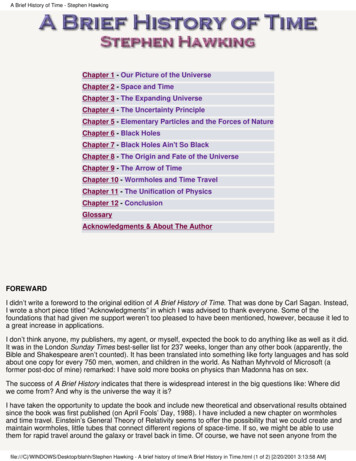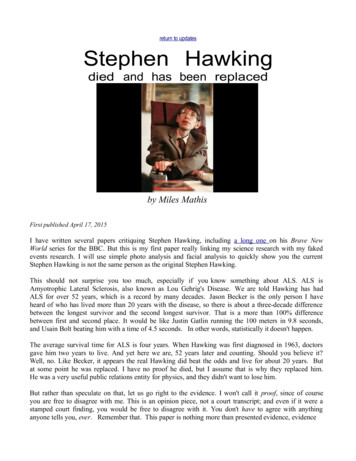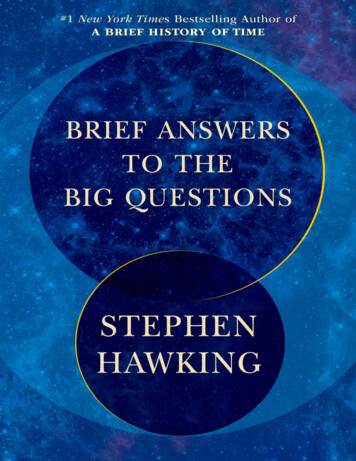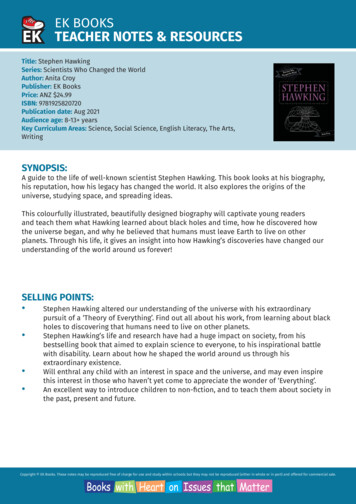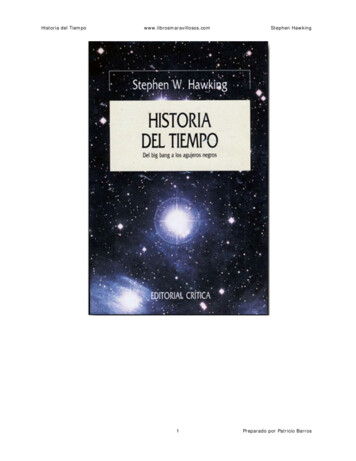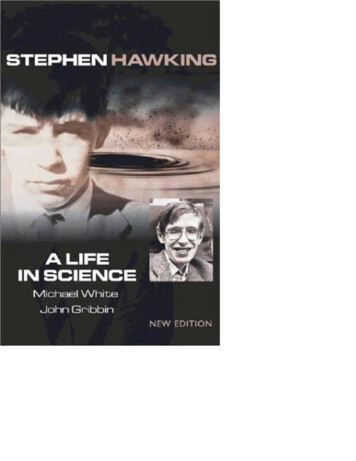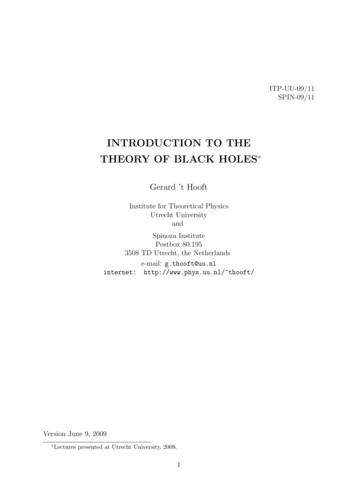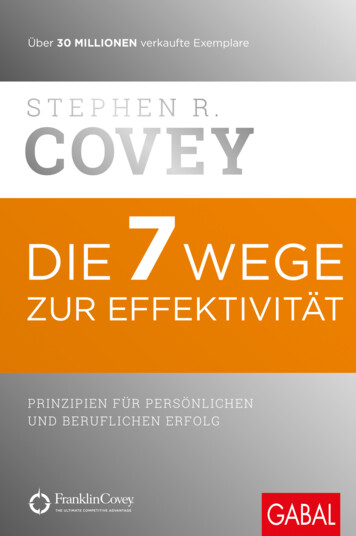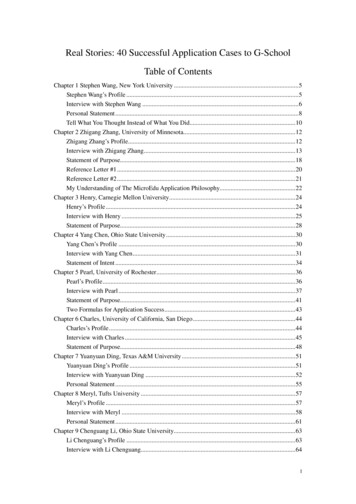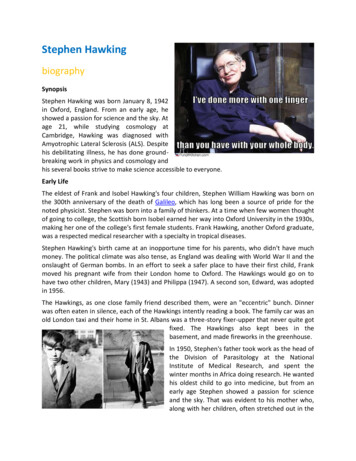
Transcription
Stephen HawkingbiographySynopsisStephen Hawking was born January 8, 1942in Oxford, England. From an early age, heshowed a passion for science and the sky. Atage 21, while studying cosmology atCambridge, Hawking was diagnosed withAmyotrophic Lateral Sclerosis (ALS). Despitehis debilitating illness, he has done groundbreaking work in physics and cosmology andhis several books strive to make science accessible to everyone.Early LifeThe eldest of Frank and Isobel Hawking's four children, Stephen William Hawking was born onthe 300th anniversary of the death of Galileo, which has long been a source of pride for thenoted physicist. Stephen was born into a family of thinkers. At a time when few women thoughtof going to college, the Scottish born Isobel earned her way into Oxford University in the 1930s,making her one of the college's first female students. Frank Hawking, another Oxford graduate,was a respected medical researcher with a specialty in tropical diseases.Stephen Hawking's birth came at an inopportune time for his parents, who didn't have muchmoney. The political climate was also tense, as England was dealing with World War II and theonslaught of German bombs. In an effort to seek a safer place to have their first child, Frankmoved his pregnant wife from their London home to Oxford. The Hawkings would go on tohave two other children, Mary (1943) and Philippa (1947). A second son, Edward, was adoptedin 1956.The Hawkings, as one close family friend described them, were an "eccentric" bunch. Dinnerwas often eaten in silence, each of the Hawkings intently reading a book. The family car was anold London taxi and their home in St. Albans was a three-story fixer-upper that never quite gotfixed. The Hawkings also kept bees in thebasement, and made fireworks in the greenhouse.In 1950, Stephen's father took work as the head ofthe Division of Parasitology at the NationalInstitute of Medical Research, and spent thewinter months in Africa doing research. He wantedhis oldest child to go into medicine, but from anearly age Stephen showed a passion for scienceand the sky. That was evident to his mother who,along with her children, often stretched out in the
backyard on summer evenings to stare up at the stars. "Stephenalways had a strong sense of wonder," she remembered. "And Icould see that the stars would draw him."Early in his academic life Stephen, while recognized as bright, wasnot an exceptional student. At one point in high school, hismother recalled, he was third from the bottom of his class.Instead, Stephen turned his mind loose on pursuits outside ofschool. He loved board games, and with a few close friendscreated new games of their own. At the age of 16 Stephen, alongwith several other buddies, constructed a computer out ofrecycled parts for solving rudimentary mathematical equations.He was also on the go a lot. "Always on the move," said a familyfriend. "Hardly ever still." With his sister Mary, Stephen, wholoved to climb, devised different entry routes into the family home. He remained active evenafter he entered Oxford University at the age of 17. He loved to dance, and also took an interestin rowing, becoming one of the Oxford rowing team's coxswain.To his father's chagrin, Hawking finally said no to medicine, instead expressing a desire to studymathematics. But since Oxford didn't offer a mathematics degree, Hawking gravitated towardphysics and, more specifically, cosmology.By his own account, Hawking didn't put much time into his studies. He would later calculatethat he averaged about an hour a day focusing on school. And yet, he didn't really have to domuch more than that. In 1962, he graduated with honors and moved on to CambridgeUniversity for a Ph.D. in cosmology.ALS DiagnosisWhile Stephen first began to notice problems with his physical health at Oxford—on occasionhe would trip and fall, or slur his speech— he didn't look into the problem until 1963, during hisfirst year at Cambridge. For the most part, HawkingQuick Factshad kept these minor symptoms to himself. But whenhis father took notice of the condition, he sent StephenNAME: Stephen Hawkingto see a doctor. For the next two weeks, the 21-yearOCCUPATION: Astronomerold college student made his home at a medical clinic,BIRTH DATE: January 08, 1942where he underwent a series of tests.(Age: 69)EDUCATION: Oxford University,Cambridge University,Caltech, Gonville & CaiusCollegePLACE OF BIRTH: Oxford, UnitedKingdomZODIAC SIGN: Capricorn"They took a muscle sample from my arm, stuckelectrodes into me, and injected some radio opaquefluid into my spine, and watched it going up and downwith x-rays, as they tilted the bed," he said. "After allthat, they didn't tell me what I had, except that it wasnot multiple sclerosis, and that I was an a-typical case."Eventually, however, doctors did inform the Hawkingsabout what was ailing their son: he was in the early
stages of Amyotrophic Lateral Sclerosis (ALS or LouGehrig's disease). In a very simple sense, the nerves thatcontroled his muscles were shutting down. Doctors gavehim two-and-half years to live.It was devastating news for Stephen and his family. A fewevents, however, prevented him from becomingcompletely despondent. The first of these came whileHawking was still in the hospital. There, he shared a roomwith a boy suffering from leukemia. Relative to what hisroommate was going through, Stephen reflected later, hissituation seemed more tolerable. Not long after he wasreleased from the hospital, Hawking had a dream he wasgoing to be executed. He said this dream made himrealize that there were still things to do with his life.But the most significant change in his life was the factthat he was in love. At a New Year's part in 1963, shortly before he had been diagnosed withALS, Stephen Hawking met a young languages undergraduate named Jane Wilde. They weremarried in 1965.In a sense, Hawking's disease helped him become the noted scientist he is today. Before thediagnosis, Stephen Hawking hadn't always focused on his studies. "I was bored with life beforemy illness," he said. "There had not seemed to be anything worth doing." With the suddenrealization that he might not even live long enough to earn his Ph.D., Hawking pored himselfinto his work and research.Research on Black HolesGroundbreaking findings from another young cosmologist, Roger Primrose, about the fate ofstars and the creation of black holes tapped into Hawking's own fascination with how theuniverse began. This set him on a career course that reshaped the way the world thinks aboutblack holes and the universe.While physical control over his body diminished (he'd be forced to use a wheelchair by 1969),the effects of his disease started to slow down. In 1968, a year after the birth of his son Robert,Stephen Hawking became a member of the Institute of Astronomy in Cambridge.The next few years were a fruitful time for Hawking. A daughter, Lucy, was born to Stephen andJane in 1969 (a third child, Timothy, arrived 10 years later), while Hawking continued with hisresearch. He then published his first book, the highlyBest Known Fortechnical Large Scale Structure of Space Time (1975). HeStephen Hawking is known for hisalso teamed up with Penrose to expand upon his friend'swork regarding black holes and hisearlier work.several popular science books. Hesuffers from amyotrophic lateralsclerosis (ALS).In 1974, Stephen Hawking's research turned him into acelebrity within the scientific world when he showed thatblack holes aren't the information vacuum that scientists
had thought they were. In simple terms, Hawkingdemonstrated that matter, in the form of radiation, canescape the gravitational force of a collapsed star. HawkingRadiation was born.The announcement sent shockwaves of excitement throughthe scientific world, and put Hawking on a path that's beenmarked by honors, notoriety, and distinguished titles. He wasnamed a fellow of the Royal Society at the age of 32, and laterearned the prestigious Albert Einstein Award. In 1975 hejourneyed to Rome, where he was honored with the Pius XIGold Medal for Science from Pope Paul VI.Teaching stints followed, too. One at Caltech at Pasadena,California, where Hawking served as visiting professor for a year. Another at Gonville & CaiusCollege in Cambridge, England. In 1979, Hawking found himself back at Cambridge University,where he was named to one of teaching's most renowned posts: the Lucasian Professor ofMathematics. Dating back to 1663, the position has had just 14 other office holders, includingSir Isaac Newton.A Brief History of TimeHawking's ever-expanding career was accompanied, however, by his ever-worsening physicalstate. By the mid-1970s, the Hawking family had taken in one of Stephen's graduate students tohelp manage his care and work. He could still feed himself and get out of bed, but virtuallyeverything else required assistance. In addition, his speech had become increasingly slurred, sothat only those who knew him well could understand him. In 1985 he lost his voice for goodfollowing a tracheotomy operation. The resulting situation required 24-hour nursing care forthe acclaimed physicist.It also put in peril Hawking's ability to do his work. The predicament caught the attention of aCalifornia computer programmer, who had developed a speaking program that could bedirected by head or eye movement. The invention allowed Hawking to select words on acomputer screen that were then passed through a speech synthesizer. At the time of itsintroduction, Hawking, who still had use of his fingers, selected his words with a hand-heldclicker. Today, with virtually all control of his body gone, Hawking directs the program througha cheek muscle attached to a sensor.Through the program, and the help of assistants, Stephen Hawking has continued to write at aprolific rate. His work has included numerous scientific papers, of course, but also informationfor the non-scientific community, too.QuotesGod not only plays dice. Hesometimes throws the dice wherethey cannot be seen.– Stephen HawkingIn 1988 Hawking, a recipient of the Commander of theOrder of the British Empire, catapulted to internationalprominence with the publication of A Brief History ofTime. The short, informative book became an accountof cosmology for the masses. The work was an instantsuccess, spending more than four years atop the
London Sunday Times' bestseller list. Since its publication, it has sold more than 25 millioncopies worldwide and been translated into more than 40 languages. But it also wasn't as easyto understand as some had hoped. So in 2001, Hawking followed up his book with The Universein a Nutshell, which offered a more illustrated guide to cosmology's big theories. Four yearslater, he authored the even more accessible, A Briefer History of Time.Together the books, along with Hawking's own research and papers, articulate the physicist'spersonal search for science's Holy Grail: a single unifying theory that can combine cosmology(the study of the big) with quantum mechanics (the study of the small) to explain how theuniverse began. It's this kind of ambitious thinking that has allowed Hawking, who claims he canthink in 11 dimensions, to lay out some big possibilities for humankind. He's convinced thattime travel is possible, and that humans may indeed colonize other planets in the future.Space Travel and Further FameHawking's quest for big answers to big questionsincludes his own personal desire to travel into space. In2007, at the age of 65, Hawking made an importantstep toward space travel. While visiting the KennedySpace Center in Florida, he was given the opportunityto experience an environment without gravity. Overthe course of two hours over the Atlantic, Hawking, apassenger on a modified Boeing 727, was freed fromhis wheelchair to experience bursts of weightlessness.Pictures of the freely floating physicist splashed acrossnewspapers around the globe."The zero-G part was wonderful and the higher-G partwas no problem. I could have gone on and on. Space, here I come!" he said.If there is such a thing as a rock star scientist, Stephen Hawking embodies it. His forays intopopular culture have included guest appearances on The Simpsons, Star Trek: The NextGeneration a comedy spoof with comedian Jim Carrey on Late Night with Conan O'Brien, even arecorded voice-over on the Pink Floyd song, "Keep Talking."In 1992, Oscar winning filmmaker, Errol Morris, released a documentary about Hawking's lifeaptly titled A Brief History of Time.Of course, as it is with any celebrity, fame has brought with it an interest in Stephen Hawking'spersonal life. And there have been some news-making events. In 1990, Stephen left his wifeJane for one of his nurses, Elaine Mason. The two were married in 1995, and the marriage put astrain on Hawking's relationship with his own children, who claimed Elaine closed off theirfather from them. In 2004, nurses looking after Hawking reported their suspicions to police thatElaine was physically abusing her husband. Hawking denied the allegations, and the policeinvestigation was called off.
In 2006, however, Hawking and Elaine filed for divorce. Inthe years since, the physicist has apparently grown closerwith his family. He's reconciled with Jane, who hasremarried, and published a science book for children withhis daughter, Lucy.Hawking's health, of course, remains a constant concern—aworry that was heightened in early 2009 when he failed toappear at a conference in Arizona because of a chestinfection. In April 2009, Hawking, who had alreadyannounced he was retiring after 30 years from the post ofLucasian Professor of Mathematics at Cambridge University,was rushed to the hospital for being what university officials described as "gravely ill." It waslater announced that he was expected to make a full recovery.Hawking is scheduled to fly to the edge of space as one of Sir Richard Branson's pioneer spacetourists. He said when asked about the subject in 2007, "Many people have asked me why I amtaking this flight. I am doing it for many reasons. First of all, I believe that life on Earth is at anever increasing risk of being wiped out by a disaster such as sudden global warming, nuclearwar, a genetically engineered virus, or other dangers. I think the human race has no future if itdoesn't go into space. I therefore want to encourage public interest in space."In September 2010, Stephen Hawking spoke against the idea that God could have created theuniverse in his book, The Grand Design. Hawking previously argued that belief in a creator couldbe compatible with modern scientific theories. His new work, however, concludes that the BigBang was the inevitable consequence of the laws of physics and nothing more. "Because thereis a law such as gravity, the universe can and will create itself from nothing," Hawking says."Spontaneous creation is the reason there is something rather than nothing, why the universeexists, why we exist."The Grand Design is Hawking's first major publication in almost a decade. Within his new work,Hawking sets out to challenge Sir Isaac Newton's belief that the universe had to have beendesigned by God, simply because it could not have been born from chaos. "It is not necessary toinvoke God to light the blue touch paper and set the universe going," Hawking said.Stephen Hawking. (2011). Biography.com. Retrieved 02:09, Nov 08, 2011 g-9331710What is ALS?Amyotrophic lateral sclerosis (ALS), often referred to as "Lou Gehrig's Disease," is aprogressive neurodegenerative disease that affects nerve cells in the brain and thespinal cord. Motor neurons reach from the brain to the spinal cord and from the spinalcord to the muscles throughout the body. The progressive degeneration of the motorneurons in ALS eventually leads to their death. When the motor neurons die, the ability
of the brain to initiate and control muscle movement is lost. With voluntary muscleaction progressively affected, patients in the later stages of the disease may becometotally paralyzed.A-myo-trophic comes from the Greeklanguage. "A" means no or negative."Myo" refers to muscle, and "Trophic"meansnourishment–"Nomusclenourishment." When a muscle has nonourishment, it "atrophies" or wastesaway. "Lateral" identifies the areas in aperson's spinal cord where portions ofthe nerve cells that signal and controlthe muscles are located. As this areadegenerates it leads to scarring orhardening ("sclerosis") in the region.As motor neurons degenerate, theycan no longer send impulses to themuscle fibers that normally result inmuscle movement. Early symptoms ofALS often include increasing muscleweakness, especially involving thearms and legs, speech, swallowing or breathing. When muscles no longer receive themessages from the motor neurons that they require to function, the muscles begin toatrophy (become smaller). Limbs begin to look "thinner" as muscle tissue atrophies.Although the cause of ALS is not completely understood, the recent years have broughta wealth of new scientific understanding regarding the physiology of this disease.While there is not a cure or treatment today that halts or reverses ALS, there is oneFDA approved drug, riluzole, that modestly slows the progression of ALS as well asseveral other drugs in clinical trials that hold promise.Importantly, there are significant devices and therapies that can manage the symptomsof ALS that help people maintain as much independence as possible and prolongsurvival. It is important to remember that ALS is a quite variable disease; no two peoplewill have the same journey or experiences. There are medically documented cases ofpeople in whom ALS „burns out,‟ stops progressing or progresses at a very slow rate.To learn more about the personal stories of people who are living fully, click here. Asone man put it, “I‟ve made ALS part of my life, not my whole life.”From: http://www.alsa.org/about-als/what-is-als.html
his several books strive to make science accessible to everyone. Early Life The eldest of Frank and Isobel Hawking's four children, Stephen William Hawking was born on the 300th anniversary of the death of Galileo, which has long been a source of pride for the noted physicist.
